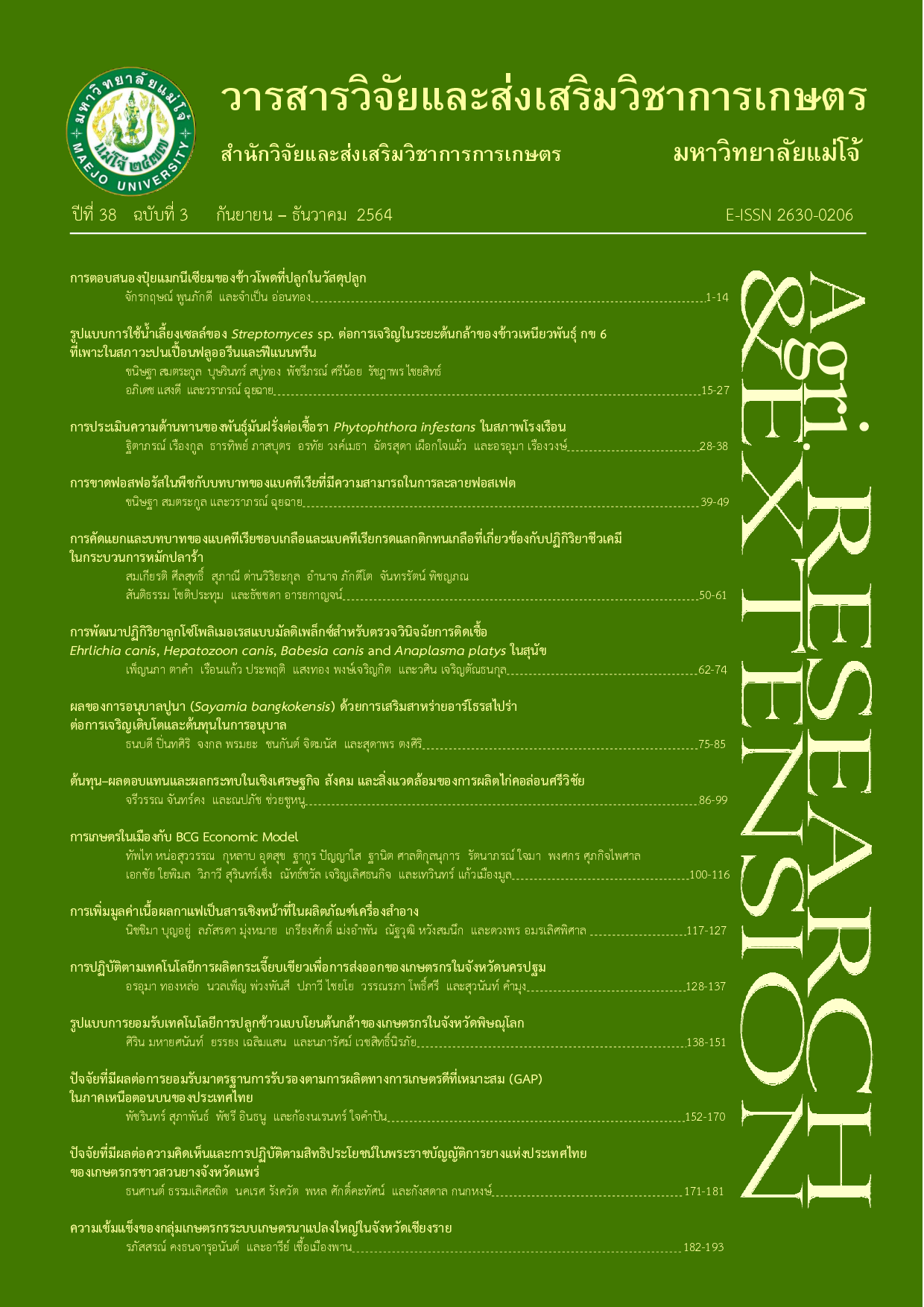รูปแบบการใช้น้ำเลี้ยงเซลล์ของ Streptomyces sp. ต่อการเจริญในระยะต้นกล้า ของข้าวเหนียวพันธุ์ กข 6 ที่เพาะในสภาวะปนเปื้อนฟลูออรีนและฟีแนนทรีน
คำสำคัญ:
กรดอินโดล-3-แอซิติก, การละลายฟอสเฟต, แบคทีเรียกลุ่มสนับสนุนการเจริญเติบโตของพืช, พอลิไซคลิกอะโรมาติกไฮโดรคาร์บอน, ข้าวเหนียวพันธุ์ กข 6บทคัดย่อ
พอลิไซคลิกอะโรมาติกไฮโดรคาร์บอน (พีเอเอช) เป็นพิษต่อสิ่งมีชีวิตรวมทั้งจุลินทรีย์ การใช้จุลินทรีย์ส่งเสริมการเจริญเติบโตของพืชในดินที่ปนเปื้อนพีเอเอชอาจลดกิจกรรมของจุลินทรีย์ลงได้ ดังนั้นการศึกษานี้จึงตรวจสอบผลของพีเอเอชบางชนิด ได้แก่ ฟลูออรีนและ ฟีแนนทรีนต่อการผลิตกรดอินโดล-3-อะซิติก และการละลายฟอสเฟตของ Streptomyces sp. ไอโซเลต STRM104 และ STRM302 ผลการทดลองพบว่าฟีแนน ทรีนลดความสามารถในการละลายฟอสเฟตของไอโซเลต STRM302 ส่วนการละลายฟอสเฟตที่ลดลงของไอโซเลต STRM104 คาดว่ามาจากผลของไดเมทิลฟอร์มาไมด์ ฟีแนนทรีนและฟลูออรีนไม่ลดการผลิตกรดอินโดล-3- อะซิติกของแบคทีเรียทั้ง 2 ไอโซเลต จากนั้นนำน้ำเลี้ยงเซลล์ของ Streptomyces sp. ไอโซเลต STRM104 และ STRM302 มาทดสอบกระตุ้นการงอกและการเจริญเติบโตของข้าวเหนียวพันธุ์ กข 6 ที่เพาะในกระดาษที่ถูกทำให้ปนเปื้อนฟลูออรีนหรือฟีแนนทรีนความเข้มข้น 20 mg/l โดยเมล็ดของข้าวเหนียวพันธุ์ กข 6 ได้รับน้ำเลี้ยงเซลล์ 2 รูปแบบ ได้แก่ การแช่เมล็ดพันธุ์ในน้ำเลี้ยงเซลล์ก่อนเพาะให้งอก หรือเพาะเมล็ดพันธุ์ให้งอกในกระดาษที่ชุ่มด้วยน้ำเลี้ยงเซลล์ ผลการทดลองพบว่าต้นกล้าข้าวเหนียวพันธุ์กข 6 ที่แช่เมล็ดในน้ำเลี้ยงเซลล์ก่อนเพาะให้งอกเจริญเติบโตได้ดีกว่าเมื่อเทียบกับการเพาะเมล็ดในกระดาษที่ชุ่มด้วยน้ำเลี้ยงเซลล์ ความยาวยอด น้ำหนักยอด และความยาวรากของข้าวเหนียวพันธุ์ กข 6 ที่แช่เมล็ดในน้ำเลี้ยงเซลล์ก่อนเพาะให้งอกมีค่ามากกว่าต้นกล้าที่ได้จากการเพาะเมล็ดในกระดาษที่ชุ่มด้วยน้ำเลี้ยงเซลล์
เอกสารอ้างอิง
Ahemad, M. and M.S. Khan. 2012. Evaluation of plant-growth-promoting activities of rhizobacterium Pseudomonas putida under herbicide stress. Ann. Microbiol. 62: 1531-1540.
Ahmad, F., I. Ahmad and M.S. Khan. 2008. Screening of free-living rhizospheric bacteria for their multiple plant growth promoting activities. Microbiol. Res. 163: 178-181.
Amagai, T., Y. Takahashi and H. Matsushita. 1999. A survey on polycyclic aromatic hydrocarbon concentrations in soil in Chiang Mai, Thailand. Environ. Int. 25: 563-572.
Bakhshandeha, E., H. Pirdashti and K.S. Lendeh. 2017. Phosphate and potassium-solubilizing bacteria effect on the growth of rice. Ecol. Eng. 103: 164-169.
Calvelo Pereira, R.C., C. Monterroso and F. Macias. 2010. Phytotoxicity of hexachlorocyclohexane: effect on germination and early growth of different plant species. Chemosphere 79: 326-333.
Chhun, T., S. Taketa, S. Tsurumi and M. Ichii. 2004. Different behaviour of indole-3-acetic acid in stimulating lateral root development in rice (Oryza sativa L.). Plant Growth Regul 43: 135-143.
Chouychai, W., T. Paemsom, C. Pobsuwan, K. Somtrakoon and H. Lee. 2016. Effect of indole-3-acetic acid-producing bacteria on phytoremediation of soil contaminated with phenanthrene and anthracene by mungbean. Environment Asia 9(2): 128-133.
Chuanren, D., W. Bochu, L. Wanqian, C. Jing, L. Jie and Z. Huan. 2004. Effect of chemical and physical factors to improve the germination rate of Echinaceae angustifolia seeds. Colloid Surface B 37: 101-105.
Collavino, M.M., P.A. Sansberro, L.A. Mroginski and O.M. Aguilar. 2010. Comparison of In Vitro solubilization activity of diverse phosphate-solubilizing bacteria native to acid soil and their ability to promote Phaseolus vulgaris growth. Biol. Fert. Soils 46: 727-738.
de Souza, R., A. Ambrosini and L.M.P. Passaglia. 2015. Plant growth-promoting bacteria as inoculants in agricultural soils. Genet. Mol. Biol. 38(4): 401-419.
Hamayun, I.M., A. Hussain, S.A. Khan, A. Iqbal and I.-J. Lee. 2019. Aspergillus flavus promoted the growth of soybean and sunflower seedlings at elevated temperature. BioMed Res. Int. 2019: 1295457.
Irha, N., J. Sleta and V. Petersell. 2003. Effect of heavy metals and PAH on soil assessed via dehydrogenase assay. Environ. Int. 28: 779-782.
Khunkhet, S. and T. Remsungnen. 2018. Non-destructive identification of breeding rice seed by using image processing and fuzzy logic. J. Sci. Eng. Res. 5(3): 108-121
Kim, L., H.-J. Jeon, Y.-C. Kim, S.-H. Yang, H. Choi, T.-O. Kim and S.-E Lee. 2019. Monitoring polycyclic aromatic hydrocarbon concentrations and distributions in rice paddy soils from Gyeonggi‑do, Ulsan, and Pohang. App. Biol. Chem 62: 18.
Liu, G., W. Guo, J. Niu, X. An and L. Zhao. 2017. Polycyclic aromatic hydrocarbons in agricultural soils around the industrial city of Changzhi, China: characteristics, spatial distribution, hotspots, sources, and potential risks. J. Soils Sediments 17: 229-239.
Muniroha, M.S., S.A. Nusaibah, G. Vadamalai and Y. Siddique. 2019. Proficiency of biocontrol agents as plant growth promoters and hydrolytic enzyme producers in Ganoderma boninense infected oil palm seedlings. Current Plant Biology 20: 100116.
Patel, A.B., S. Shaikh, K.R. Jain, C. Desai and D. Madamwar. 2020. Polycyclic aromatic hydrocarbons: sources, toxicity, and remediation approaches. Front. Microbiol 11: 562813.
Pongpiachan, S., D. Tipmadee, W. Deelaman, J. Muprasit, P. Feldensand and K. Schwarzer. 2013. Baseline risk assessment of the presence of polycyclic aromatic hydrocarbons (PAHs) in coastal areas of Thailand affected by the 2004 tsunami. Mar. Pollut. Bull. 76: 370-378.
Pongpiachan, S., M. Hattayanone and J. Cao. 2017. Effect of agricultural waste burning season on PM2.5-bound polycyclic aromatic hydrocarbon (PAH) levels in Northern Thailand. Atmos. Pollut. Res. 8: 1069-1080.
Somtrakoon, K., C. Chaimuangkoon, D. Phalaphol and W. Chouychai. 2011. Phytotoxicity of fluoranthene and phenanthrene contaminants in soil on crop seedling growth. RMUTI J. Sci. Technol. 4(1): 19-26. [in Thai].
Somtrakoon, K., C. Chaimuangkoon, D. Phalaphol and W. Chouychai. 2012. Combined phytotoxicity of phenanthrene, fluorene and fluoranthene in seedling growth of sticky rice cv. RD 6 and water morning glory. Rajamangala University of Technology Tawan-ok Res. J. 5(1): 35-45. [in Thai].
Sverdrup, L.E., F. Ekelund, P.H. Krogh, T. Nielsen and K. Johnsen. 2002. Soil microbial toxicity of eight polycyclic aromatic compounds: effects on nitrification, the genetic diversity of bacteria, and the total number of protozoans. Environ. Toxicol. Chem. 21: 1644-1650.
Vejan, P., R. Abdullah, T. Khadiran, S. Ismail and A.N. Boyce. 2016. Role of plant growth promoting rhizobacteria in agricultural sustainability – A review. Molecules 21: 573.
Wu H., B. Sun and J. Li. 2019. Polycyclic aromatic hydrocarbons in sediments/soils of the rapidly urbanized lower reaches of the river Chaohu, China. Int. J. Env. Res. Pub. He. 16: 2302.
Zelinkova, Z. and T. Wenzl. 2015. The occurrence of 16 EPA PAHs in food – A review. Polycycl. Aromat. Comp. 35: 248-284.
ดาวน์โหลด
เผยแพร่แล้ว
รูปแบบการอ้างอิง
ฉบับ
ประเภทบทความ
สัญญาอนุญาต
บทความนี้ได้รับการเผยแพร่ภายใต้สัญญาอนุญาต Creative Commons Attribution-NonCommercial-NoDerivatives 4.0 International (CC BY-NC-ND 4.0) ซึ่งอนุญาตให้ผู้อื่นสามารถแชร์บทความได้โดยให้เครดิตผู้เขียนและห้ามนำไปใช้เพื่อการค้าหรือดัดแปลง หากต้องการใช้งานซ้ำในลักษณะอื่น ๆ หรือการเผยแพร่ซ้ำ จำเป็นต้องได้รับอนุญาตจากวารสาร





